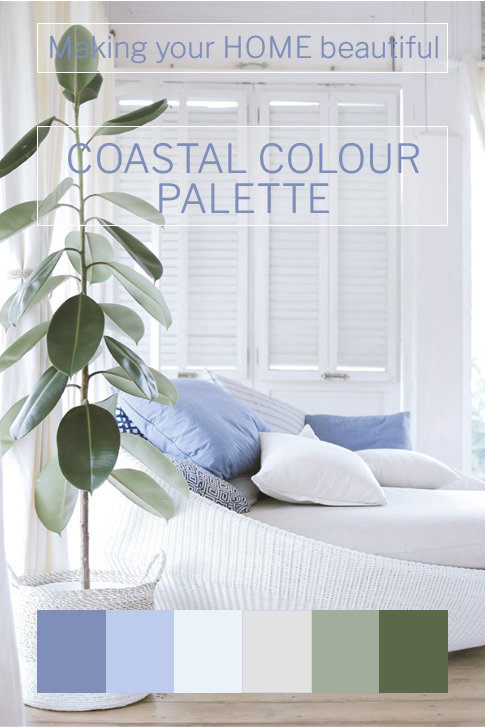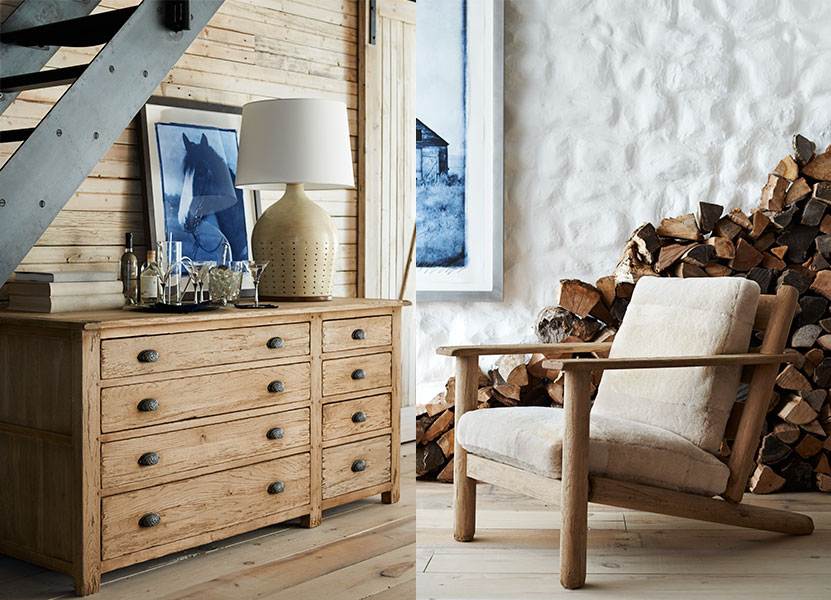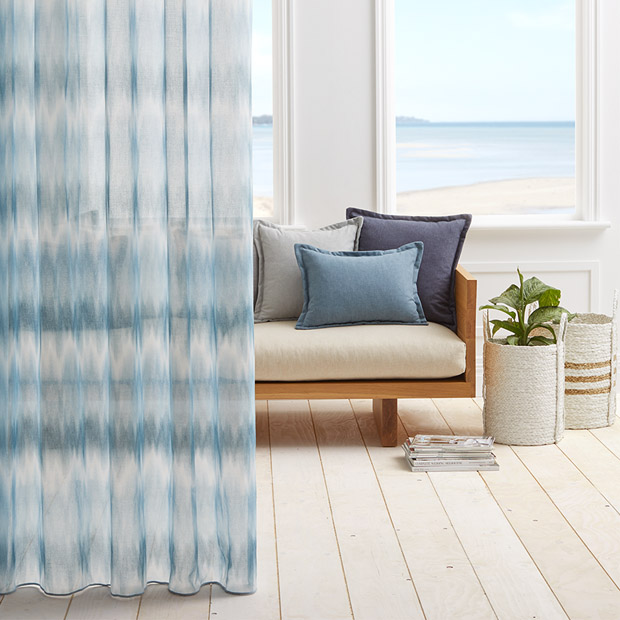Interior Styles, Interiors
My top 7 tips for a Classic Coastal Scheme
Have you noticed that interiors are very neutral now? I'm sure there is no way that you couldn't have done. White and Grey are the neutrals of the moment and of course they are very stylish. Scroll through Pinterest and you will see that so many coastal schemes are also now very neutral, but what if you really want to incorporate the colours of the ocean into your decorating scheme? I call this the classic coastal look – one that endures through the vagaries of popular trends.

I have 7 tips for how to achieve a classic coastal scheme below – let me show you how.
1) Keep it relaxed
There is an art to the shabby look that really suits a classic coastal style. The key is to keep it simple with nothing that is too precious or perfect but without it looking cheap and uncared for.

Related: The Art of Shabby

2) The right colour palette
Without doubt white or a soft pale grey are the best choices to use for walls in a coastal look, whilst bringing in colour and warmth with soft furnishings and accessories. Carefully consider which white to use though as you need to create a look that is light and airy but it must be comfortable. If your room has little light and a cool aspect you will need to find a warm soft chalky white. However if you have an abundance of light and warmth you will need a cooler, fresher white. Or you could afford to use a soft grey.
Remember that the trim that you use with grey walls can make a big impact. A fresh white makes the grey look cleaner and fresher, while a trim in the same colour gives a more urban feel to the room.

My view on the classic coastal scheme is that in addition to using the beautiful neutrals of the beach you also should include the colours of the ocean. This sets it apart from a more neutral coastal scheme. There is something about the inclusion of beautiful blues from dark navy through to pale aqua that really says Classic Coastal style.

Related: Country Home Ideas – Colours for a Coastal Style
Related: How to find the right white

3) Use natural fabrics for upholstery, cushions and bedlinen
When it comes to selecting the right fabrics, opt for soft linens and washable cottons. White slip covers are perfect for this type of scheme as they can easily be laundered, maintaining a fresh, clean look. Vintage linens work well as the older they get, the softer they become. You can also consider using a linen mix fabric that has some polyester to stand up to wear and tear. The fabrics to avoid for the coastal look are velvets, satins and man-made fabrics that have a shiny appearance.


Related: How to choose the right upholstery fabric
Timber is a great addition to a coastal scheme, in fact it really should be included in at least one guise, ideally in a few. Weathered finishes, limewashed timbers, reclaimed timbers and natural stone are ideal for a coastal look. Even white painted timber or bricks look great as you still have that natural look.


Related: Painting bricks white
5) Employ layers of different textures
Use plenty of rugs to zone areas and to introduce layers over stone and timber floors. Rugs made from wool, hemp and sisal are ideal in this setting with designs that are textured rather than plain suiting the look best. Avoid the traditional three piece seating solutions and use rattan chairs partnered with soft, squidgy sofas. Remember that pieces don’t have to match, they just need to comfortably sit alongside each other. The last thing you want in a classic coastal scheme is formality!

Related: How to select the right rug
Related: The Rattan trend – how to incorporate it in your home
6) Accessorise
Finishing touches will really help to complete the story of a scheme. Without these the room is not complete. Employ hurricane lamps and groups of candles to set the scene and remember that groupings of odd numbers work the best. Oversized rattan trays that conjure up long lunches and afternoon teas with piles of interesting magazines and books to help while away the hours. Soft, comfortable cushions to curl up against and tactile throws to add warmth and interest will complete the picture.

Remember that a classic coastal look shouldn't look too perfect – you can also have a bit of fun with a look like this, so if you want to introduce a classic coastal piece – a pair of oars, a surfboard or a lifesaving ring – feel free to.

Related: A Coastal Style Vignette
Related: Accessories for a coastal home you can't do without

7) Finally, the ambient temperature
Don’t forget to plan for all seasons so that your coastal home is comfortable all year round. I actually love being by the coast in the middle of winter, so open fires are a must to create a really inviting look, whilst large doors that can be opened up for the summer months are crucial. Don't forget to set the mood outside too – a fire pit is a great way to make use of the outdoors all year round.
Related: 7 tips for a Neutral Beachside Scheme
Related: Australian Coastal Style – 7 tips to achieve this look

I have lots of ideas and inspiration on my Pinterest page and it would be great to hear your decorating problems in the comments section below and whether you are planning a coastal style look for your home. Do you love using the classic blues in your coastal scheme or do you prefer a more pared back neutral look?

I have a FREE Resources Library which has lots of e-books and comprehensive interior and exterior checklists to help you with your next new build, renovation or decorating project. You can sign up for FREE here.

Interesting how the use of blue in most of those room scenes if not described as a coastal setting you would gather that anyway, the power of suggestive colour.
Yes, I agree Kate. I think that out of all the design elements, colour is the most powerful – I particularly love how Ralph Lauren has used the Navy Blue – one of my favourite colours.
Hi Sam
Just read your 7 tips classic coastal look. Just what I would like in our new home. Love the blues whites and timber look.
Will keep reading your wonderful articles.
Cheers
Di Sinclair
Hi Di
Lovely to hear from you and I am so glad you love the articles. The classic coastal look is a favourite of mine too as it works so well with our lifestyle – I love the laid back look too where nothing is too perfect. Thanks Sam x
Hi Samantha
Love your articles. We are about to renovate a small beach house in Queensland. What flooring do you suggest? Everyone keeps suggesting this hybrid floor boards compared to wooden floor boards, and to carpet the bedrooms. What are your thoughts?
Hi Lisa I agree that a mix of hard flooring for the living/kitchen areas etc. and carpet for the bedrooms is a good combination. Carpet cuts down on cost and is also nice and comfortable in a bedroom. However the choice between a hybrid type and real timber is a big one as they both have their good and bad points. I assume you are talking about an engineered timber floor? You need to look carefully at warranties etc as they are all so different. Some have up to 7 layers of polyurethane in their coating and are extremely tough and suited to commercial environments but some may only have 2 layers and therefore not as scratch resistant. Also some can be sanded and re-finished over time and others only have a very thin piece of timber which is difficult to sand. You also have the option now of vinyl flooring in a timber look and again these vary hugely in quality. The good ones are very effective and hard wearing. Real timber is still my favourite as it doesn’t go out of fashion. You can re-sand it many times and it tends to look more natural – it will scratch easier though. Real timber can be more expensive as you have to install it, and it should be left on site for a while to acclimatise. You then have to finish it so the process is more involved. There isn’t a right or wrong, you really just have to do your research on any type of hybrid flooring for warranties etc. and then look at lots of images to see whether you are drawn to these or the more traditional Aussie hardwood timber look. It will depend on the look that you want for your home, how much wear and tear you think it will get and whether you like the idea of being able to resand and finish when you want to. Hope this hasn’t confused you more than help you! Samantha
Hi Samantha,
I really like your blogs and E-Books! I am just repainting our beach house on the south coast of NSW. Exterior is weather boards, I was thinking of Taubmans “Sailing” with white trim (windows, barge boards etc).
The interior has natural stained pine timber boards running vertically from the skirting board to about half way up the gyprock walls, the timber having a trim at the top. The timber is rather dominant as it is throughout the whole house, so I am thinking of painting the boards white (Vivid?) and the the top half of the walls a light grey, maybe Taubmans “Highgate”. Would the white colour be better at the top half or bottom half (Timber) of the walls? Do you recommend a darker grey as there seems to be very little contrast? I hope you can give me some good advice as I am not exactly sure on the best way to proceed.
Hi John Taubmans Sailing will give you a very pretty house – Dulux Highgate with Vivid White will work well together and I would definitely put the white on the base section. You will have a fair amount of contrast with Highgate but if you want more you could try Dulux Knowing. Good luck Samantha